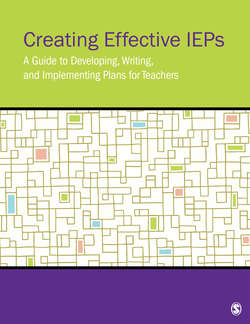Creating Effective IEPs

Реклама. ООО «ЛитРес», ИНН: 7719571260.
Оглавление
Nancy Burton. Creating Effective IEPs
Creating Effective IEPs
Brief Contents
Introduction
Chapter 1 Individualized Education Plans and the Law IFSP, IEP, ITP, and SOP
Litigation and Legislation—The Justification of Special Education
Serving a Purpose
Individualized Plans Required by IDEA 2004. The Individual Family Service Plan and Its Components
The Individualized Education Plan and Its Components
The Individualized Transition Plan and Its Components
Summary of Performance
Chapter 2 Stages of IEP Development Prereferral, Referral, Assessment, and Eligibility
Prereferral Intervention
Activity 2.1: Intervention Planning
Referral for Evaluation
Multidisciplinary Evaluation Team and Evaluation
Eligibility
Activity 2.2: Explaining the Process to Parents
Chapter 3 The IEP Team Meeting
Participants in the IEP Meeting
Writing the IEP
Present Levels of Academic Achievement and Functional Performance
Activity 3.1: Writing PLAAFPs
Annual Goals
Activity 3.2: Measurable Annual Goals
Activity 3.3: Writing Annual Goals From PLAAFPs
Stipulation of Special Education and Supplementary Aids and Related Services
Stipulation of Least Restrictive Environment and Placement Options
Stipulation of Participation in State and Districtwide Assessments
Stipulation of Location, Frequency, and Duration of Services
Transition Planning
Age of Majority
Measurement of Progress
References
Chapter 4 The Individualized Transition Plan (ITP)
Individualized Transition Plan Defined
Preparing the Individualized Transition Plan
Transition IEP Meeting
Activity 4.1: Preparing Appropriate Measurable Postsecondary Goals That Address Education
Activity 4.2: Preparing Appropriate Measurable Postsecondary Goals That Address Employment
Activity 4.3: Resource Guide for Transition Services
Chapter 5 Implementing the IEP. Effective Collaboration Between General and Special Education Teachers
Collaborative Teaching (Co-Teaching)
Collaborative Teaching Planning Tool
Co-Teaching Lesson Plan Template
Co-Teaching Lesson Plan Template—Addressing IEP Goals
Instructional Design to Address IEP Goals and Objectives
Differentiated Instruction in Inclusive Environments
Key Elements of Differentiated Instruction
Differentiating Instruction Lesson Plan Template
Activity 5.1: Differentiating Instruction
Universal Design for Learning and the Inclusive Environment. Principles of Universal Design
Elements of Universal Design for Learning
Activity 5.2: Universal Design for Learning Lesson Planning
Progress Reporting
Annual Review
Triennial Review
Activity 5.3: The IEP Process—An Interactive Experience
The Journey’s End—A New Beginning
References
Appendix A Federal Regulations TITLE 34: Education: PART 300—Assistance to States for the Education of Children With Disabilities: 300.300-300.328. Federal Regulations
Parental Consent §300.300 Parental consent
Evaluations and Reevaluations §300.301 Initial evaluations
§300.302 Screening for instructional purposes is not evaluation
§300.303 Reevaluations
§300.304 Evaluation procedures
§300.305 Additional requirements for evaluations and reevaluations
§300.306 Determination of eligibility
Additional Procedures for Identifying Children With Specific Learning Disabilities §300.307 Specific learning disabilities
§300.308 Additional group members
§300.309 Determining the existence of a specific learning disability
§300.310 Observation
§300.311 Specific documentation for the eligibility determination
Individualized Education Programs §300.320 Definition of individualized education program
§300.321 IEP Team
§300.322 Parent participation
§300.323 When IEPs must be in effect
Development of IEP §300.324 Development, review, and revision of IEP
§300.325 Private school placements by public agencies
§300.326 [Reserved] §300.327 Educational placements
§300.328 Alternative means of meeting participation
Appendix B State Special Education Websites
Appendix C Section 504 of the Rehabilitation Act of 1973
Reasonable Accommodations
Comparison Chart: Section 504 and IDEA
Appendix D CEC Code of Ethics Council for Exceptional Children. Special Education Professional Ethical Principles
Appendix E Supplemental Materials. Activity 2.1: Intervention Planning Matrix (Academic Problem Identification Process)
Activity 3.1: Writing PLAAFPs
Activity 3.3: Writing Annual Goals From PLAAFPs
Activity 4.1: Preparing Appropriate Measurable Postsecondary Goals That Address Education. Suggested Responses
Activity 4.2: Preparing Appropriate Measurable Postsecondary Goals That Address Employment. Suggested Responses
Activity 5.1: Differentiating Instruction. Differentiated Activity Worksheet
Activity 5.2: Universal Design for Learning Lesson Planning. Universal Design for Learning Lesson Plan Template
Отрывок из книги
A Guide to Developing, Writing, and Implementing Plans for Teachers
Effective educators, both special and general educators, understand the need for planning. They know that without an appropriate plan for instruction, there is little assurance that necessary content or skills will be taught. As educators, each of us knows that good planning is essential not only to our success, but also to the success of the students we teach. We also know that when students struggle, our plans must be flexible enough to change so we can appropriately address the needs of our students.
.....
Understanding the curriculum and knowing the students, both collectively and individually, are essential to understanding how instruction must be designed for the most effective outcomes. Every teacher, both general and special educators, should recognize the significance of carefully designed, student-centered instruction. Preparing an IEP for a student who has very specific academic and/or behavioral needs is both structured and intense. Fortunately, there are specific legislative and state guidelines that provide direction in the development of the individualized plans required by IDEA.
As previously noted, IDEA 2004 stipulates that individuals with disabilities (birth to 21) are entitled to receive a “free, appropriate public education” (FAPE) in the least restrictive environment (LRE). Additionally, IDEA requires the development of individualized plans for each qualifying individual. Part C of the Individuals with Disabilities Education Act (IDEA) specifically addresses programs for infants and toddlers and stipulates that an Individual Family Service Plan (IFSP) must be developed and implemented. In compliance with Part C of the IDEA, the IFSP is a written document—a plan—that delineates the early intervention services provided to an infant or toddler (birth to 3) and his or her family.
.....